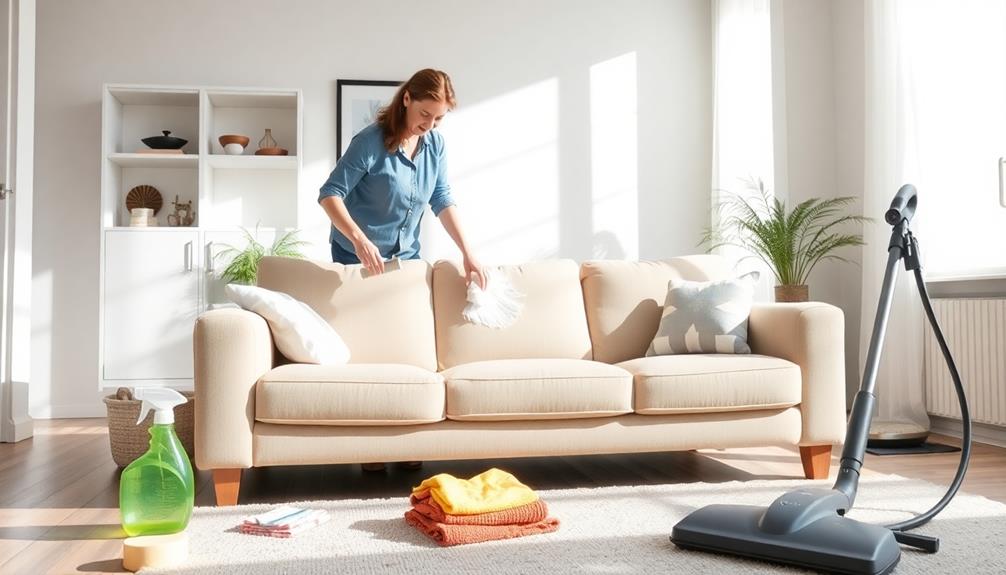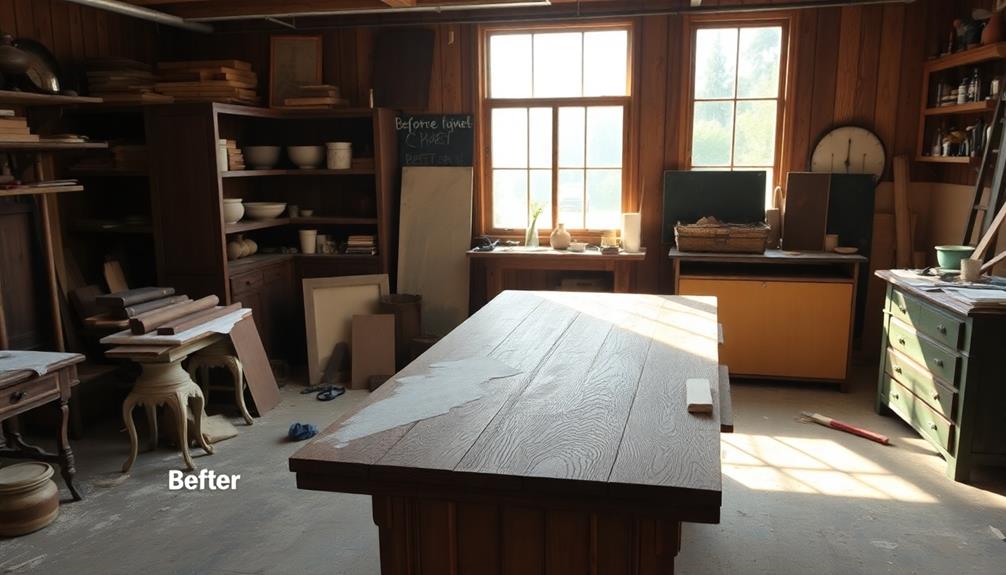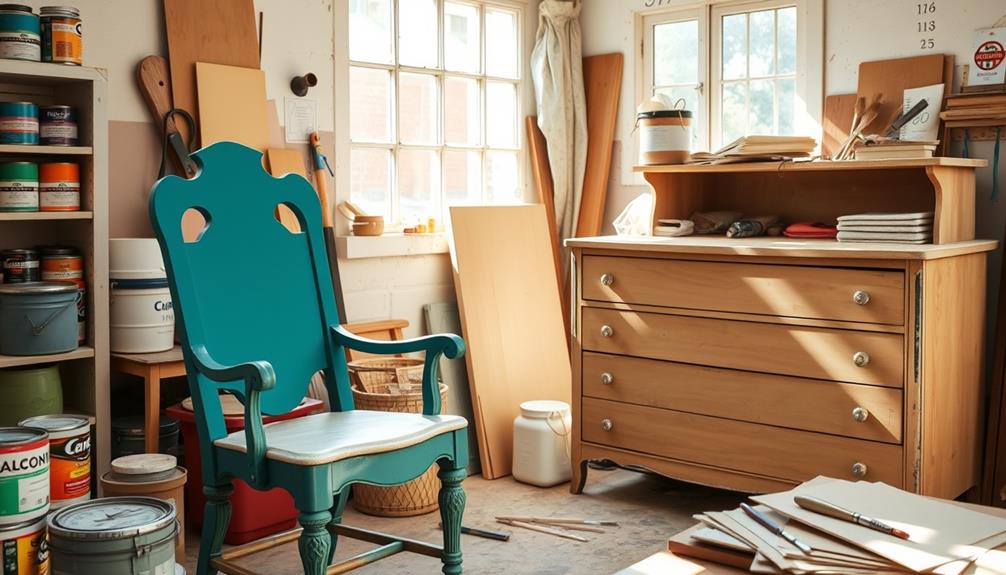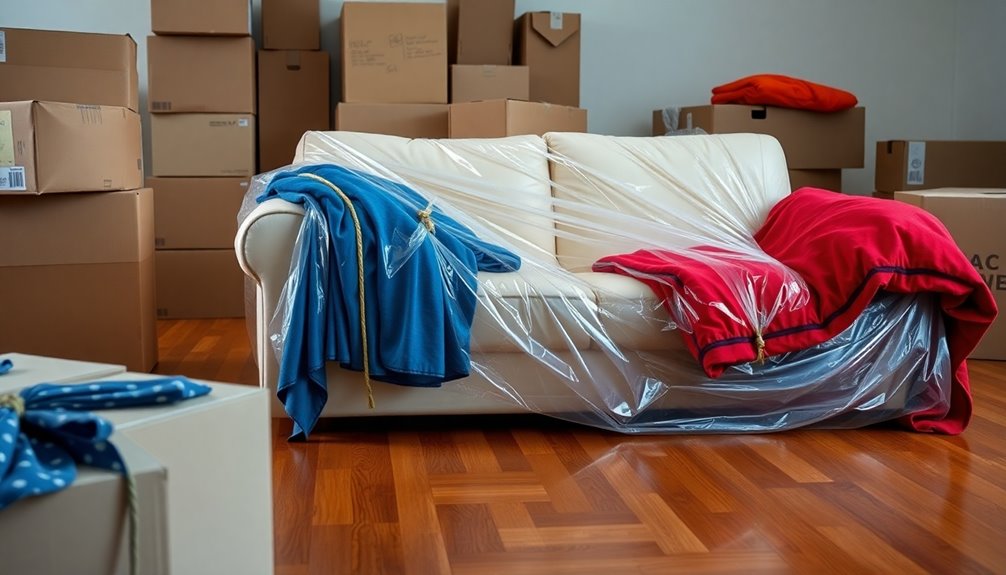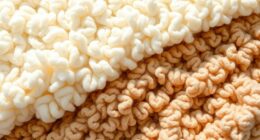To begin cleaning your upholstery sofa, it is essential to thoroughly vacuum the entire surface, including under the cushions. Determine the fabric type by checking the care tags to select the appropriate cleaning products. For stain removal, you can use a mixture of equal parts vinegar and water or a gentle detergent, but always remember to test it in a hidden spot first. Immediately blot any new stains with a microfiber cloth to prevent them from setting. Consider utilizing steam cleaning for a more thorough cleaning and ensure that the upholstery is completely dry to prevent mildew. Consistent maintenance and quick action on spills will help your sofa maintain its appearance. Explore additional effective cleaning methods to keep your sofa looking fresh!
Key Takeaways
- Vacuum the sofa thoroughly, including crevices, to remove dirt and allergens at least once a month.
- Identify the fabric type using care tags to select appropriate cleaning solutions and methods.
- Spot clean stains immediately using a mixture of vinegar and water, testing on an inconspicuous area first.
- For deeper cleaning, consider steam cleaning to lift embedded dirt and stubborn stains effectively.
- Regularly clean upholstery every 12 to 18 months and hire professionals for tough stains and odors.
Preparation for Cleaning
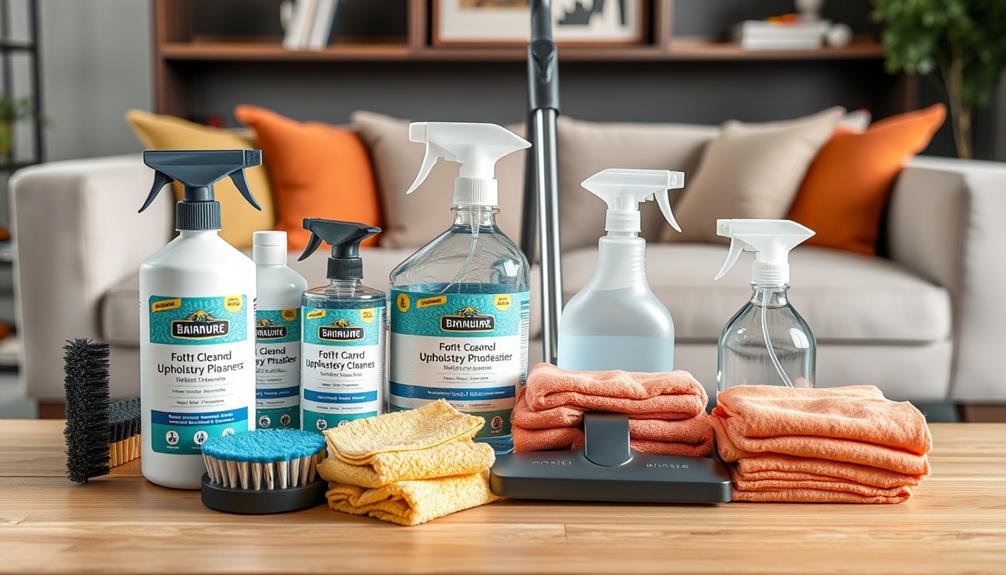
Before you start cleaning your upholstery sofa, it's vital to prepare properly. Begin by thoroughly vacuuming the entire surface, including crevices and under cushions, to remove dust, pet hair, and debris. This step sets the stage for effective cleaning and prevents dirt from being pushed deeper into the fabric.
Incorporating natural cleaning methods, such as using essential oils, can enhance the freshness of your upholstery while guaranteeing a safe environment, as some oils possess antimicrobial properties that help eliminate odors.
Next, grab a stiff brush with natural bristles to gently loosen any dirt or stains embedded in the fabric fibers. This helps lift grime without damaging the upholstery.
As you prepare, check for any removable covers. If they're machine washable, follow the care instructions on the label to make sure you clean them correctly.
It's also important to carefully read the care labels on your upholstery. This will help you identify the fabric type, distinguishing between natural fibers like cotton and linen and synthetic materials such as polyester and microfiber.
Knowing the fabric type is vital, as it guides your cleaning method and guarantees you avoid damaging the sofa. By following these steps, you'll make sure your upholstery is clean, fresh, and well cared for.
Understanding Fabric Types
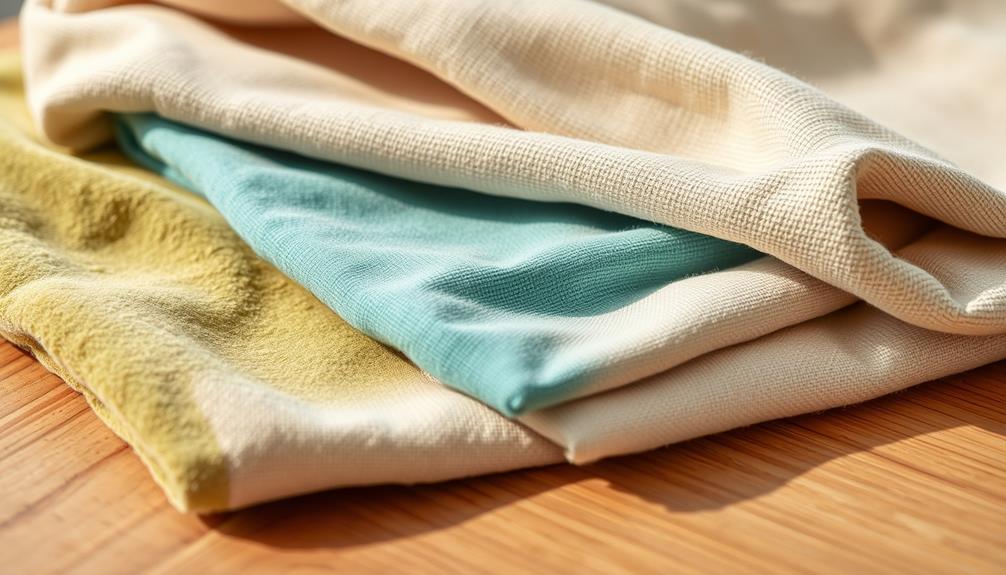
When cleaning your upholstery sofa, knowing the fabric type is essential.
Natural fibers like cotton and wool require careful handling to prevent stains, while synthetic options like polyester are usually more forgiving.
Understanding the characteristics of different fabrics can also help you avoid damaging them during the cleaning process, especially when considering the benefits of using non-toxic cleaning solutions.
Identifying the fabric will help you choose the right cleaning methods and solutions to keep your sofa looking its best.
Natural Fiber Characteristics
Natural fibers, including cotton, linen, and wool, play a significant role in upholstery, each bringing unique characteristics that affect both comfort and maintenance.
Cotton is durable and easy to clean, making it a popular choice. However, it can absorb moisture and stains quickly, so you'll want to treat spills immediately to prevent damage. Additionally, considering the importance of selecting the right cleaning methods is vital for maintaining upholstery integrity.
Linen, with its luxurious feel, is strong but wrinkles easily, requiring special care to maintain its appearance. When cleaning linen, avoid harsh chemicals and opt for gentle cleaning methods.
Wool is another excellent natural fiber; it's naturally resistant to dirt and stains due to its lanolin content. However, it can be sensitive to water and may shrink if not cleaned properly. For wool upholstery, stick to dry cleaning or use water-based cleaners specifically designed for wool.
Understanding the characteristics of these natural fibers is key when selecting appropriate cleaning methods and products. By keeping these features in mind, you can guarantee your upholstery remains beautiful and lasts longer while preventing damage.
Synthetic Fiber Properties
Upholstery options extend beyond natural fibers, with synthetic materials like polyester, nylon, and microfiber offering great durability and stain resistance.
These synthetic fibers make them perfect for high-use furniture, like sofas, where spills and stains are inevitable. One of the standout features of these fabrics is their moisture-wicking properties, which help them dry quickly and resist mildew growth, so you can enjoy your sofa without worrying about moisture damage.
Additionally, understanding the potential risks and rewards of Bitcoin IRAs can inform your investment decisions, just as knowing your fabric type influences cleaning methods.
When it comes to maintenance routines, synthetic upholstery is designed to be easy to clean. Most fabrics can handle machine washing or spot cleaning with a water-based cleaner and mild detergent, simplifying your cleaning process.
This ease of care means you can keep your upholstery looking fresh and new with minimal effort.
Additionally, while synthetic fibers generally have a lower environmental impact during production, be mindful that they may release microplastics when washed.
Understanding the specific type of synthetic fiber used in your upholstery helps you choose the most effective cleaning methods, ensuring longevity and ideal appearance.
Embrace these advantages to maintain a beautiful and functional sofa for years to come!
Identifying Fabric Types
Identifying the type of fabric on your sofa is essential for effective cleaning and maintenance. Different fabrics have unique properties that dictate how you should care for them.
Natural fibers, like cotton and linen, require special attention due to their susceptibility to staining and damage. On the other hand, synthetic fibers, such as polyester and microfiber, are generally more resistant to stains and much easier to maintain.
Understanding the right cleaning solutions can save your upholstery and help you avoid potential side effects from using inappropriate products, as seen in cold medications overview.
To help you understand the fabric types, look for these factors:
- Knowing the right cleaning solutions can save your upholstery
- Preventing stains from setting is vital for longevity
- Upholstery codes guide you on the cleaning methods to use
- Water-safe fabrics offer more flexibility in cleaning
- Recognizing fabric types can enhance your care routine
Check your sofa's label for upholstery codes: "W" for water-safe fabrics, "S" for solvent-only cleaning, "W/S" for both, and "X" for vacuuming only.
Understanding your fabric type helps you select the appropriate cleaning methods and products, ensuring you keep your sofa looking its best without causing damage.
Cleaning Techniques and Materials
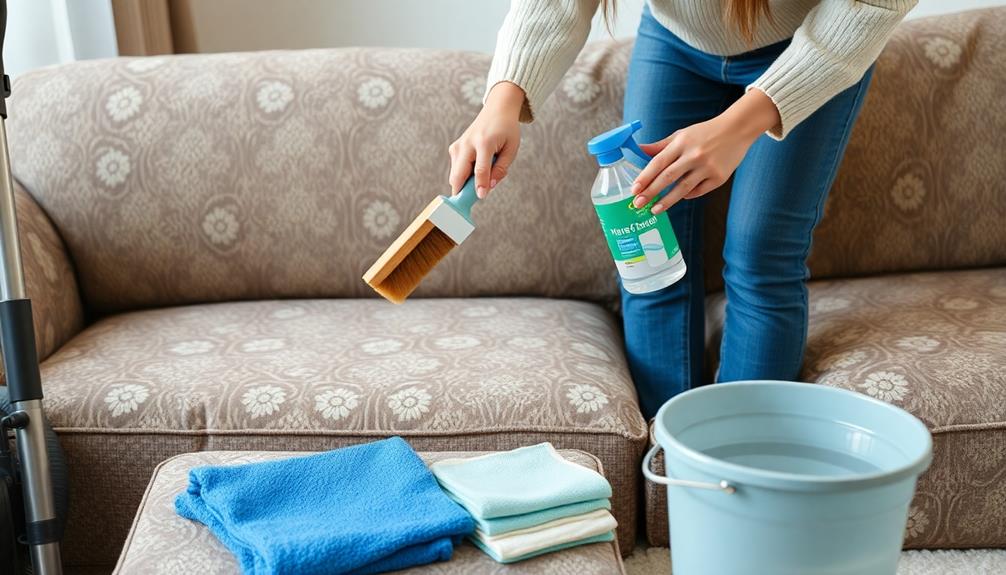
When it comes to cleaning your sofa, using the right techniques and materials is crucial for maintaining its appearance and longevity. Start by vacuuming your entire sofa, including crevices and under cushions, using a vacuum with a brush attachment for effective cleaning. Identify the upholstery fabric type using care tags; this will help you select appropriate cleaning solutions.
For spot cleaning, create a cleaning solution using equal parts vinegar and water or a mild detergent. Always perform a spot test on an inconspicuous area first to prevent damage. If your sofa needs a deeper clean, consider steam cleaning. This method effectively lifts embedded dirt and stains while sanitizing the fabric without adding excess moisture.
After cleaning, verify your upholstery air-dries completely to prevent mildew. You might also consider applying a fabric protector like Scotchgard to repel future stains.
| Type of Fabric | Recommended Cleaning Method |
|---|---|
| W (Water) | Water-based cleaning solution |
| S (Solvent) | Solvent-based cleaning products |
| WS (Both) | Either water or solvent methods |
| X (No Liquids) | Dry cleaning only |
Stain Removal Methods
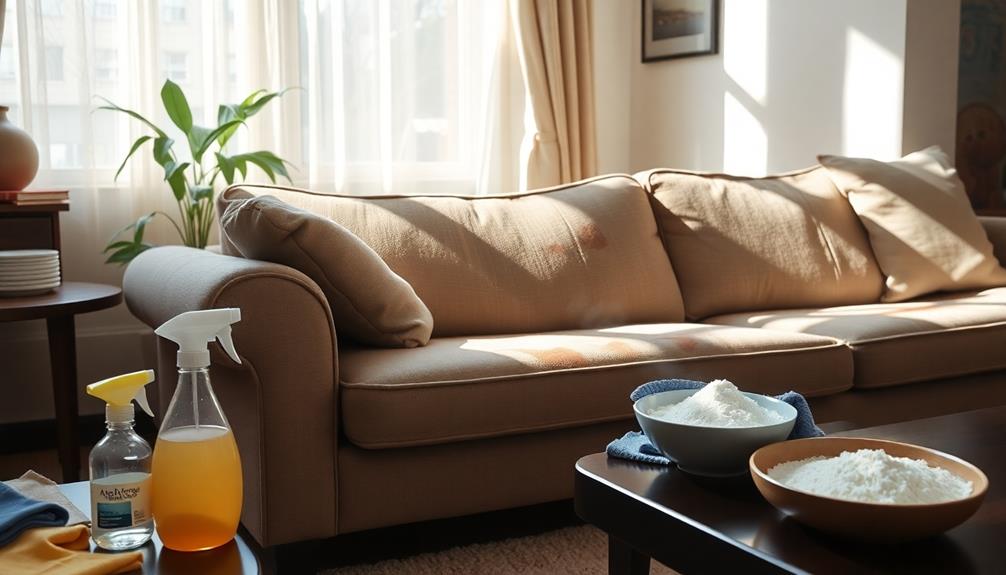
When you spot a stain on your upholstery, act fast to blot it with a clean microfiber towel before it sets in.
For those stubborn stains, effective DIY solutions using common household items can make a big difference.
For instance, combining vinegar and water can create a powerful cleaning solution, similar to the benefits of natural cleaning methods found in other areas of home care.
Let's explore the best methods to tackle both fresh and persistent stains effectively.
Immediate Stain Treatment
To tackle stains on your upholstery sofa effectively, act quickly and blot fresh stains immediately with a clean, absorbent cloth. This method soaks up as much liquid as possible without rubbing, which can spread the stain further.
For oil-based stains, use a solvent-based cleaning agent that matches your upholstery code, allowing it to dry completely before checking for any residue. Additionally, maintaining a clean environment can help reduce the frequency of stains, similar to how air quality considerations can impact the cleanliness of your living space.
If you're dealing with water-based stains, mix vinegar and water, then gently blot the area with this solution. Follow up with a clean damp cloth to remove any leftover mixture.
When you face stubborn stains, steam cleaning can be a game-changer. It loosens the stains, making them easier to blot away with a microfiber cloth.
Remember, always test any cleaning solution on an inconspicuous area of the fabric first to verify it won't cause discoloration or damage.
Here are a few thoughts to keep in mind:
- Protect your furniture's beauty.
- Avoid permanent damage.
- Keep your space inviting.
- Maintain your investment.
- Enjoy a fresh, clean home.
Effective DIY Solutions
Effective DIY solutions can save the day when it comes to removing stains from your upholstery sofa. For fabric upholstery, mix equal parts vinegar and water, adding a few drops of dish soap. This method isn't only cost-effective but also aligns with the principles of using energy-efficient appliances to reduce overall household consumption.
Apply this cleaning solution to the stain using a microfiber cloth and blot gently. Always perform a spot test on an inconspicuous area first to avoid any damage or discoloration.
For oil-based stains, consult your upholstery code instructions and use a solvent-based cleaner. Allow it to dry completely before addressing any residue.
If you're dealing with stubborn stains, steam cleaning can effectively lift embedded dirt, so be sure to follow the manufacturer's guidelines for your specific fabric type.
To tackle greasy stains, create a paste from baking soda and water. Apply it to the stain, let it sit for 15-30 minutes, then gently wipe it away with a damp cloth.
Odor Elimination Tips
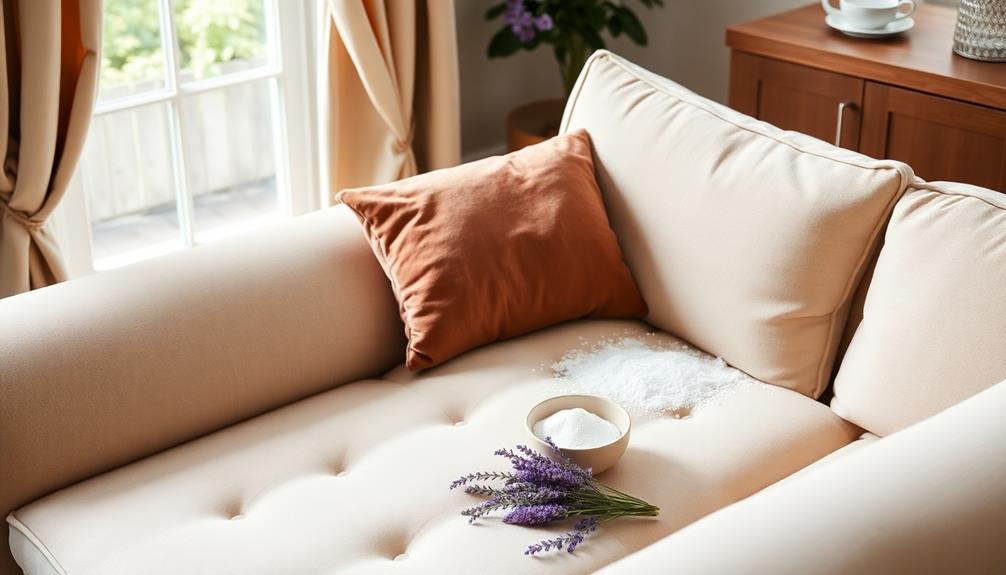
Odor elimination is essential for maintaining a fresh and inviting living space, especially when it comes to upholstery. You want your sofa to feel welcoming, not stale or musty. Here are some effective tips to tackle those unpleasant smells:
- Breathe easy—eliminate odors for a comfortable environment. Incorporating a consistent cleaning routine can also help maintain freshness, similar to how yoga practices for back pain emphasize regularity for ideal results.
- Enjoy your space—keep your upholstery inviting for friends and family.
- Feel confident—fresh-smelling furniture enhances your home's appeal.
- Stay proactive—addressing odors early prevents bigger issues down the line.
- Rest easy—a clean sofa promotes a healthier home atmosphere.
Start by identifying the fabric type of your upholstery before applying any liquid solutions to avoid damage.
For a quick fix, sprinkle baking soda evenly over the sofa and let it sit for at least 15-30 minutes. This will absorb odors effectively.
If you face persistent smells, mix equal parts white vinegar and clean water in a spray bottle, lightly mist the affected areas, and let it air dry.
For pet odors, consider using enzymatic cleaners that break down the organic compounds causing the smell.
Regular cleaning and immediate attention to spills help keep your upholstery fresh and odor-free.
Maintenance and Care

Regular maintenance is key to keeping your upholstery sofa looking great and lasting longer. Start by vacuuming your sofa at least once a month. This simple task helps prevent dirt buildup and allergens, ensuring the longevity of your fabric upholstery.
Additionally, using a well-draining soil for your indoor plants can help create a cleaner air environment in your home. Don't forget to deep clean your sofa every 12 to 18 months, especially if you have pets or use it frequently. This helps maintain hygiene and comfort.
When it comes to cushions, fluffing and rotating them regularly is essential. This practice maintains their shape and prevents uneven wear, enhancing the overall appearance of your sofa.
If you encounter spills or stains, act quickly. Blot the area with an absorbent cloth immediately to prevent long-term damage.
To further protect your investment, consider applying a protective spray like Scotchgard. This helps repel stains and liquids, particularly on absorbent fabrics. Just remember to reapply periodically for continued effectiveness.
Professional Cleaning Options
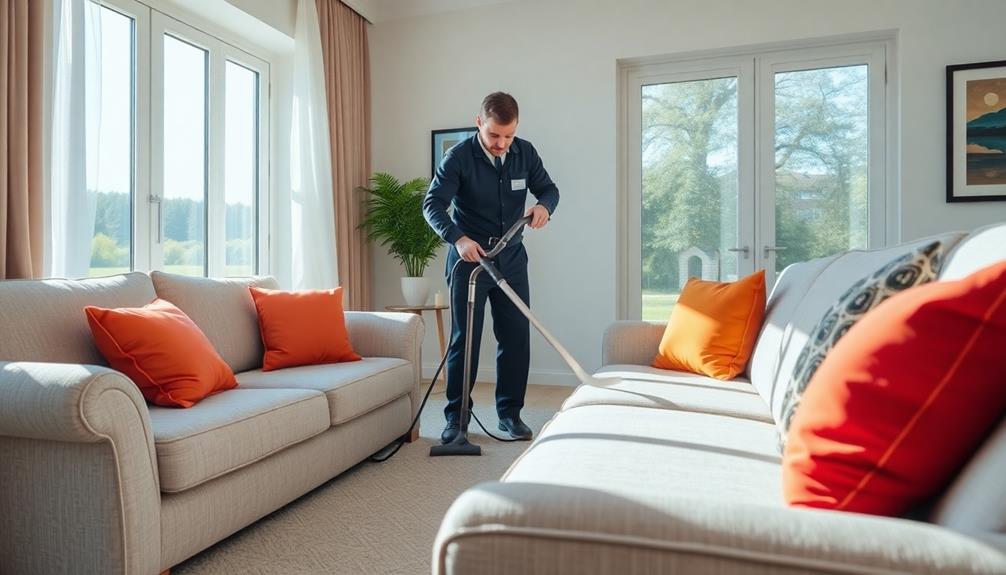
When your upholstery sofa needs a deep clean, turning to professional cleaning options can make all the difference. Hiring experts for professional upholstery cleaning is vital every 1-2 years to tackle deep-set stains and odors that regular cleaning just can't fix.
Professionals utilize specialized equipment and cleaning solutions designed for different fabric types, ensuring a thorough and safe clean. Additionally, just as in software quality assurance, attention to detail is significant in achieving the best results in upholstery cleaning, as it allows for the identification and treatment of stubborn stains effectively.
Key traits of successful engineers also apply in this context, where expertise and methodical approaches contribute to superior outcomes.
Here's why you should consider professional services:
- Experience that guarantees results
- Access to advanced, specialized equipment
- Tailored cleaning solutions for your upholstery
- Protective treatments that help repel future stains
- Time-saving convenience for your busy schedule
Consulting local services can provide you with quotes and specific cleaning options based on your upholstery.
By choosing professionals, you not only achieve a level of cleanliness that's tough to replicate at home, but you also maintain fabric integrity, ensuring your sofa looks great for years to come.
Common Upholstery Mistakes

Even after hiring professionals for a thorough clean, it's important to be aware of common upholstery mistakes that can undermine your efforts. Ignoring upholstery care tags can lead to using the wrong cleaning product, resulting in damaging the fabric. Always check the care codes to avoid catastrophic decisions.
Another mistake is neglecting to vacuum regularly. Dirt from fabric can accumulate, causing permanent stains that are tough to remove. Additionally, excessive water can create water stains and promote mold growth, especially in moisture-sensitive fabrics.
Don't forget to spot test any cleaning solution on an inconspicuous area before applying it broadly. This step is essential to prevent irreversible damage if the fabric reacts poorly. Finally, avoid direct sunlight during the drying process; ignoring this can lead to fading and deterioration.
| Mistake | Consequence | Solution |
|---|---|---|
| Ignoring care tags | Using wrong cleaning product | Always read the tags |
| Not vacuuming regularly | Embedded dirt and stains | Vacuum at least once a week |
| Skipping spot tests | Irreversible damage | Always spot test beforehand |
| Excessive moisture | Mold and mildew growth | Use minimal water and soft bristle |
Frequently Asked Questions
How Do You Clean a Fabric Upholstered Couch?
To clean a fabric upholstered couch, vacuum it monthly, check the care label, spot clean with a vinegar and soap mixture, blot stains quickly, and use baking soda to keep it smelling fresh.
How to Clean Dirty Sofa Upholstery?
To clean dirty sofa upholstery, start by vacuuming thoroughly. Then, identify the fabric type, spot clean with a vinegar-water solution, and treat odors using baking soda. For deep cleaning, consider using a steam cleaner.
What Is the Best Thing to Clean a Sofa With?
You'd think cleaning a sofa is simple, right? Well, it depends on the fabric. For many, a mix of warm water, vinegar, and dish soap works wonders. Just remember to test it first! However, for more delicate materials like velvet or silk, you might need to use specialized cleaners or even consider professional help to avoid damage. When **cleaning your sofa at home**, always check the manufacturer’s label for specific care instructions. Taking the time to use the right method ensures your sofa stays fresh and maintains its quality for years to come.
What Do Professionals Use to Clean Upholstery?
Professionals use commercial-grade steam cleaners and specialized upholstery solutions tailored to fabric types. They often pre-treat stains, employ portable extractors, and may apply fabric protectants afterward to keep your upholstery looking fresh and clean.
Conclusion
Now that you're equipped with the knowledge to clean your upholstery sofa, imagine the joy of sinking into a fresh, inviting space, much like a cozy haven after a storm. By taking care of stains, odors, and regular maintenance, you can preserve the beauty of your furniture and create a warm atmosphere for your loved ones. So, roll up your sleeves and breathe new life into your sofa—it deserves a little TLC, just like you do.
